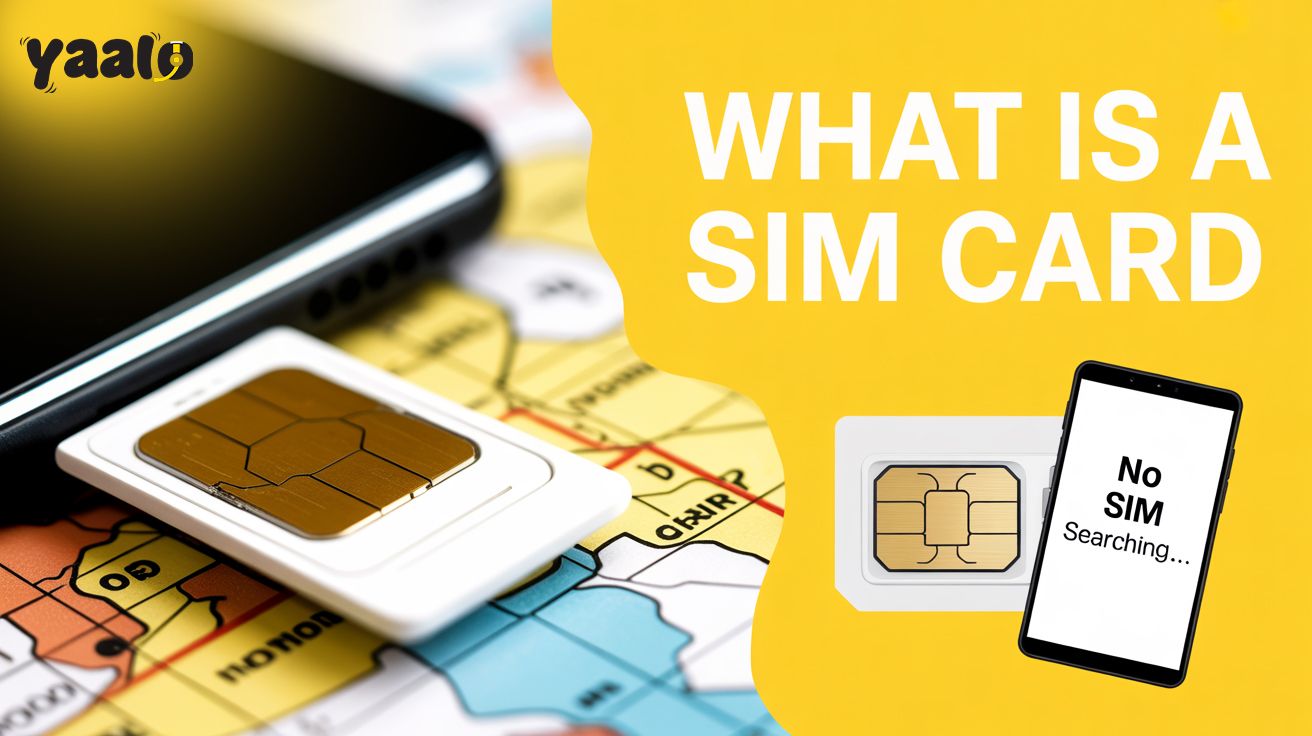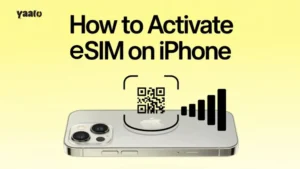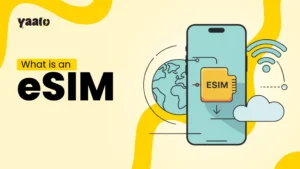When was the last time you thought about the tiny chip inside your phone? Probably never until you’re switching phones, traveling abroad, or upgrading to something sleeker, like an eSIM.
Whether you have a traditional Physical SIM Card or just heard about eSIMs, knowing what a SIM card is can help you. This knowledge can lead to better choices, especially when you travel alone internationally or upgrade your device.
Let’s learn about some of the real stuff.
What Exactly is a SIM Card?
A Subscriber Identity Module or SIM Card is a miniature chip inside your phone. It connects you to your mobile network. Like, your device is saying, “Hey, I belong to this phone number, and here’s my data plan.” The main function of a SIM Card is to verify the address with the mobile network operator
It holds your identity for the network (like your phone number and carrier info). Lets you make calls, use mobile data, and even store a few contacts or texts if needed. Think of it as your phone’s passport—without it, your device has no idea where it belongs or what plan it has.

Why SIM Cards Even Matter?
For most people, SIM cards just sit inside their phones quietly doing their job. But they actually manage a lot behind the scenes:
- They connect you to your mobile network.
- They authenticate your identity so no one else can use your number.
- They carry your mobile number wherever you go.
- They store backup info like contacts or text messages (especially older SIMs).
Without them, you’d basically have a fancy camera with no way to text or call anyone.
The Evolution of the SIM Cards: From Chunky to Invisible!
Let’s walk through how SIM cards shrink with time:
- Full-size SIM: The size of a credit card (seriously).
- Mini SIM: Slightly smaller, still used in early smartphones.
- Micro SIM: More compact, used in many Androids pre-2015.
- Nano SIM: Tiny and used in most modern smartphones today.
- eSIM (Embedded SIM): Built into your phone—no card swapping, no plastic.
That brings us to the now: eSIMs. Instead of popping in a physical chip, you download your carrier profile directly onto your device. Simple, secure, and eco-friendly.
What’s Inside a SIM Card?
Even though it looks tiny, there’s a lot packed into it. It has an integrated circuit card identifier for a cellular network.
- IMSI (your international mobile identity)
- Network credentials for connecting securely
- Phone number association
- Carrier access keys
- Security info like PIN/PUK codes
- Sometimes, even your contacts and texts
Basically, it’s the reason your phone knows you’re on your carrier’s network.
What Types of SIM Cards Exist Today?
The SIM card has different types now because everything digital today needs connectivity. There is always a better technology solution. The following are the types of Physical cards rather than standard sim:
By Form Factor
- Physical SIM: Still used widely. Plug-and-play.
- eSIM: Digital and embedded—download your mobile plan remotely.
- iSIM (Integrated SIM): Still emerging; integrated into your phone’s processor.
By Usage Model
- Prepaid SIMs: Load credit, no contracts. Ideal for travel.
- Postpaid SIMs: Monthly billing plans.
By Network Compatibility
- 3G, 4G, 5G... each network generation supports its own SIM type for speed and access.
- 5G is the latest Internet technology adopted by many carriers worldwide. It all depends upon your eSIM-compatible device specifications.
Why are SIM Cards Important For Travellers?
If you’ve ever stepped off a plane and seen “No Service” on your phone, you’ve met the limits of your SIM. Traditional SIMs are tied to one country or region, and that’s where eSIMs pop ups as a companion.
With an eSIM like Yaalo, you can land with instantly connect to a local network without fumbling for a store or swapping tiny chips. Just scan a QR code, download your plan, and boom, you’re online.
SIM Card Limitation and Why eSIMs are the Future?
The real truth is SIM cards worked fine for years, but they’ve got baggage:
- You need to remove and insert them physically
- They can get lost, damaged, or stolen
- Swapping them while traveling is inconvenient
- They take up space inside your phone
With eSIM technology, you can eliminate all of this. You will get:
- Instant plan activation
- Multiple carrier profiles on one device
- No need to visit a shop or buy hardware
- Seamless switching between countries
- Savings due to cheap plans
How can You Upgrade from a SIM Card to Yaalo eSIM?
Upgrading to an eSIM through Yaalo is easy and takes just minutes:
- Check if your phone supports eSIM (iPhones from XR and newer, Samsung Galaxy S20 and up, Google Pixel 3+).
- Go to Yaalo.com and choose your destination
- Pick a plan (local, regional, or global)
- Scan the QR code
- Activate—and you’re connected instantly!
- No SIM trays. No roaming shocks. Just affordable data anywhere you go!
Conclusion
SIM cards have powered our mobile lives for decades. But the world is moving fast, and physical chips just can’t keep up with our needs. We need instant, secure, and global connectivity.
That’s why platforms like Yaalo eSIM are leading the way. Whether you’re planning a business trip or a backpacking adventure, eSIMs offer the flexibility, simplicity, and peace of mind. You cant have this with traditional SIM cards.
FAQs
Can I still use my old SIM card with a new eSIM-compatible phone?
Yes, if your phone has a physical SIM slot. But if you’re switching to eSIM, you can transfer your number digitally in most cases.
Is eSIM safe to use compared to physical SIMs?
Absolutely. eSIMs are actually more secure because there’s no risk of someone physically stealing your SIM card.
- How to Activate eSIM on iPhone: 4 Easy Methods (2025 Guide) - October 15, 2025
- Top 5 Scholarships for Spain in 2025 - October 1, 2025
- What is an IMEI Number and How to Find it? - September 23, 2025







